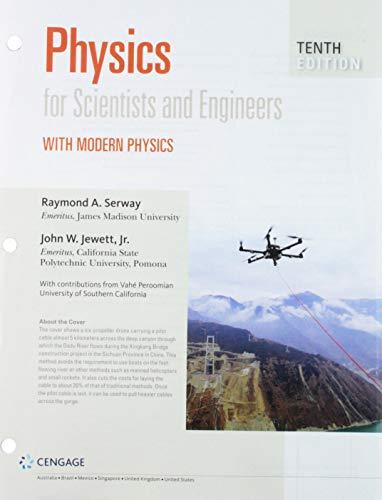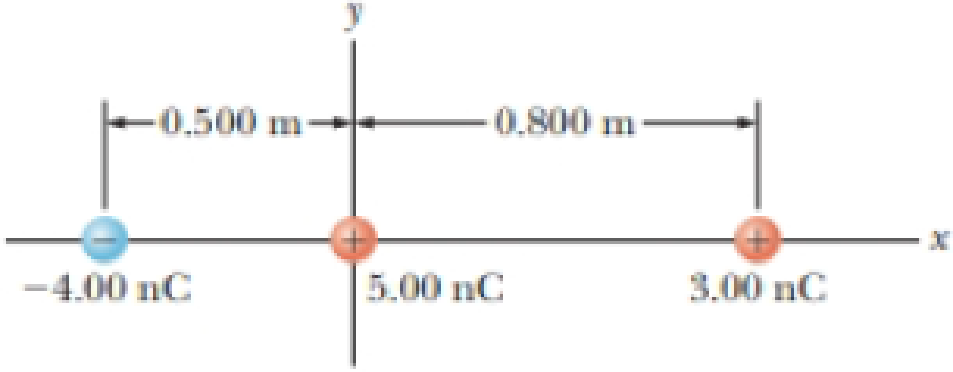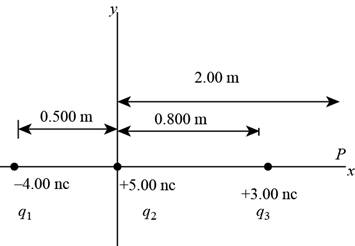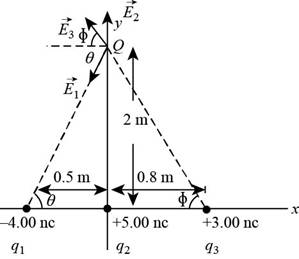
Concept explainers
Three charged particles are aligned along the x axis as shown in Figure P22.35. Find the electric field at (a) the position (2.00 m, 0) and (b) the position (0, 2.00 m).
Figure P22.35

(a)
The electric field at the position
Answer to Problem 35AP
The electric field at the position
Explanation of Solution
Given Info: Three charges are acting on the same line along the
According to Coulomb’s law, the electric field created by a charge
Here,
The electric field at a point due to number of charges is resultant of the electric field due to the individual charges.
The figure for the position of point charges is shown below.

Figure (1)
The electric field due to charge
Here,
Substitute
The electric field due to charge
Here,
Substitute
The electric field due to charge
Here,
Substitute
The resultant electric field can be given as,
Here,
Substitute
Thus, the electric field at position
Conclusion:
Therefore, the electric field at the position
(b)
The electric field at the position
Answer to Problem 35AP
The electric field at the position
Explanation of Solution
Given Info: Three charges are acting on the same line along the
The figure for the position of point charges is shown below,

Figure (2)
According to Pythagoras theorem, the distance between the charge
Here,
According to Pythagoras theorem, the distance between the charge
Here,
The electric field due to charge
Here,
Substitute
In component form the electric field can be written as,
According to right angle triangle property,
And,
Substitute
The electric field due to charge
Here,
Substitute
The electric field due to charge
Here,
Substitute
In component form the electric field can be written as,
According to right angle triangle property,
And,
Substitute
The resultant electric field can be given as,
Here,
Substitute
Thus, the electric field at position
Conclusion:
Therefore, the electric field at position
Want to see more full solutions like this?
Chapter 22 Solutions
Bundle: Physics For Scientists And Engineers With Modern Physics, Loose-leaf Version, 10th + Webassign Printed Access Card For Serway/jewett's Physics For Scientists And Engineers, 10th, Single-term
Additional Science Textbook Solutions
College Physics: A Strategic Approach (3rd Edition)
Campbell Essential Biology with Physiology (5th Edition)
Fundamentals Of Thermodynamics
Organic Chemistry
Anatomy & Physiology (6th Edition)
Biology: Life on Earth (11th Edition)
- Plz solution should be complete No chatgpt pls will upvote .arrow_forwardA box with friction coefficient of 0.2 rests on a 12 foot long plank of wood. How high (in feet) must one side of the plank be lifted in order for the box to begin to slide?arrow_forwardWhat is a good general rule to follow in order to find the best choice of coordinate system to solve a dynamics problem?arrow_forward
- What is the meaning of a first order approximation?arrow_forwardNo chatgpt pls will upvote Already got wrong chatgptarrow_forwardA hydrogen atom has just a single electron orbiting the nucleus, which happens to be a single proton without any neutrons. The proton is positively charged, the electron negatively, but both with the same magnitude of charge given by e=1.602x10-19C. The mass of an electron is 9.11x10-31kg, and the proton is 1.67x10-27kg. Find the ratio of the electrostatic to the gravitational force of attraction between the electron and the proton in hydrogen. \arrow_forward
- What is the third law pair to the normal force as you sit in a chair? What effect does the sun's pull on earth have in terms of third law pairs?arrow_forwardUsing Newton's 2nd law, show that all objects subject to the pull of gravity alone should fall at the same rate. What is that rate?arrow_forwardNo chatgpt pls will upvotearrow_forward
 Physics for Scientists and EngineersPhysicsISBN:9781337553278Author:Raymond A. Serway, John W. JewettPublisher:Cengage Learning
Physics for Scientists and EngineersPhysicsISBN:9781337553278Author:Raymond A. Serway, John W. JewettPublisher:Cengage Learning Physics for Scientists and Engineers with Modern ...PhysicsISBN:9781337553292Author:Raymond A. Serway, John W. JewettPublisher:Cengage Learning
Physics for Scientists and Engineers with Modern ...PhysicsISBN:9781337553292Author:Raymond A. Serway, John W. JewettPublisher:Cengage Learning Physics for Scientists and Engineers: Foundations...PhysicsISBN:9781133939146Author:Katz, Debora M.Publisher:Cengage Learning
Physics for Scientists and Engineers: Foundations...PhysicsISBN:9781133939146Author:Katz, Debora M.Publisher:Cengage Learning Principles of Physics: A Calculus-Based TextPhysicsISBN:9781133104261Author:Raymond A. Serway, John W. JewettPublisher:Cengage Learning
Principles of Physics: A Calculus-Based TextPhysicsISBN:9781133104261Author:Raymond A. Serway, John W. JewettPublisher:Cengage Learning College PhysicsPhysicsISBN:9781285737027Author:Raymond A. Serway, Chris VuillePublisher:Cengage Learning
College PhysicsPhysicsISBN:9781285737027Author:Raymond A. Serway, Chris VuillePublisher:Cengage Learning College PhysicsPhysicsISBN:9781305952300Author:Raymond A. Serway, Chris VuillePublisher:Cengage Learning
College PhysicsPhysicsISBN:9781305952300Author:Raymond A. Serway, Chris VuillePublisher:Cengage Learning





